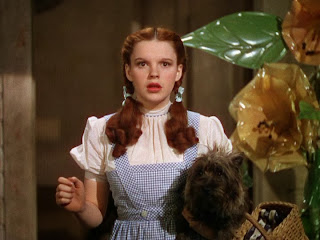 |
| Screengrab from the 2009 Blu-Ray edition Pictures from DVDbeaver |
 |
| "JUDY'S GOT THE POX!" Nope, that's film grain. |
Is it possible to remove film grain? Yes, however, the results are often held to be detrimental as this basically blurs the image so the grain disappears. Sure, in high definition, the image may look sharp, but a lot of detail has actually been lost in this process.
 |
| "The grain's gone!" And so's the whites of her eyes... |
Furthermore, film enthusiasts believe that since movies like The Wizard of Oz were filmed on film, the grain should be retained so it still looks like film. There are people who believe movies should be tinkered with until they "look real," but can any of us really say that we should mess that much with a film, particularly one so classic as Oz? Would making the movie look like a live sporting event really improve it?
I say, NO. The look of the film—even if limited by the time it was made—was how the crew wanted it to look. If we remove that, the film is no longer what people saw in theaters. Would The Wizard of Oz be as magical if we recolored it to look like modern photography instead of Technicolor?
Furthermore, such a conversion simply would not be possible. At least, not in high-definition. The loss of detail that would happen by eliminating film grain would actually require making the picture smaller so as not to look artificial.
 |
| Screencap from the 2005 DVD release |



1 comment:
Great article. Very interesting and informative.
Post a Comment